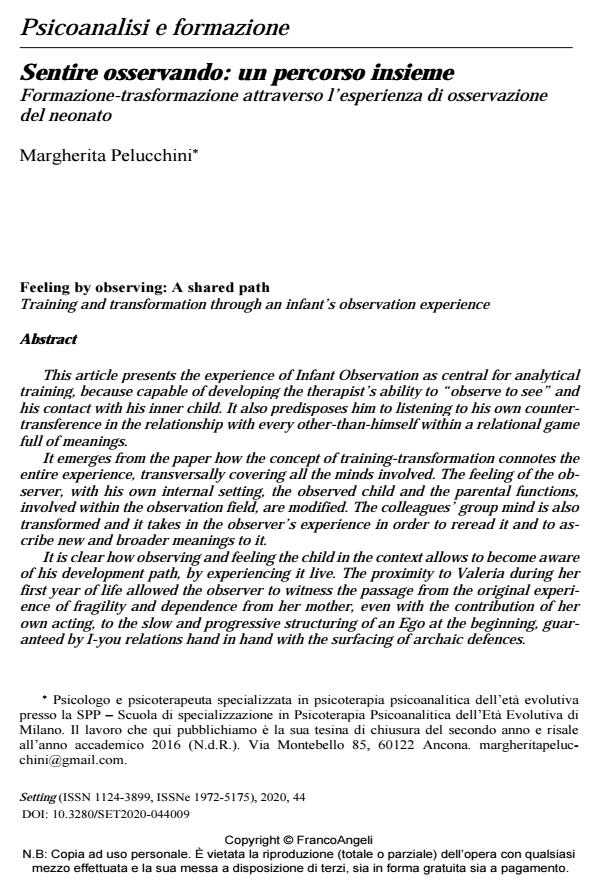Feeling by observing: A shared path Training and transformation through an infant’s observation experience
Journal title SETTING
Author/s Margherita Pelucchini
Publishing Year 2021 Issue 2020/44
Language Italian Pages 32 P. 165-196 File size 370 KB
DOI 10.3280/SET2020-044009
DOI is like a bar code for intellectual property: to have more infomation
click here
Below, you can see the article first page
If you want to buy this article in PDF format, you can do it, following the instructions to buy download credits

FrancoAngeli is member of Publishers International Linking Association, Inc (PILA), a not-for-profit association which run the CrossRef service enabling links to and from online scholarly content.
This article presents the experience of Infant Observation as central for analyti-cal training, because capable of developing the therapist’s ability to "observe to see" and his contact with his inner child. It also predisposes him to listening to his own countertransference in the relationship with every other-than-himself within a relational game full of meanings. It emerges from the paper how the concept of training-transformation connotes the entire experience, transversally covering all the minds involved. The feeling of the observer, with his own internal setting, the observed child and the parental func-tions, involved within the observation field, are modified. The colleagues’ group mind is also transformed and it takes in the observer’s experience in order to reread it and to ascribe new and broader meanings to it. It is clear how observing and feeling the child in the context allows to become aware of his development path, by experiencing it live. The proximity to Valeria dur-ing her first year of life allowed the observer to witness the passage from the origi-nal experience of fragility and dependence from her mother, even with the contribu-tion of her own acting, to the slow and progressive structuring of an Ego at the be-ginning, guaranteed by I-you relations hand in hand with the surfacing of archaic defences. During the Infant Observation the function of the child’s skin and the progres-sive integration between soma, psyche and affectivity were central, even in the ap-pearance of symptoms of discomfort within primary relationships. It was possible to witness Valeria’s sensory and motor-praxic development, parallel to the verbal one and the maturation of cognitive abilities, of the imitative skill and of what appeared to be a rising theory of mind. Routines and social development have also appeared. The reflection on the construct of attachment was crucial throughout all the path. Taken as a whole, the article shows how the Infant Observation involves a con-stant inner work within the observer, a reading and rereading of the countless ele-ments of the field of observation such as sensations, emotions, thoughts, doubts, fears looking for a plot and a sense. A cardinal aspect regards how to portray the "after" and the greetings, the possibility to part with the other keeping good thoughts, with confidence in him and his resources. A phase of mourning is neces-sary, being a source of profound teachings and internal metamorphosis.
Keywords: Infant Observation, countertransference, training, group, development path, relations.
Margherita Pelucchini, Sentire osservando: un percorso insieme Formazione-trasformazione attraverso l’esperienza di osservazione del neonato in "SETTING" 44/2020, pp 165-196, DOI: 10.3280/SET2020-044009